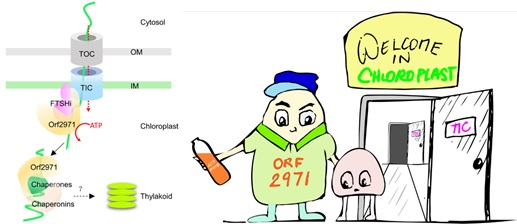
In a recent study published online in The Plant Cell, Prof. YANG Wenqiang's research team from the Institute of Botany of the Chinese Academy of Sciences (IBCAS) has reported the critical role of the largest protein Orf2971 encoded by the Chlamydomonas reinhardtii plastid genome in protein translocation and quality control.
Chloroplasts are semi-autonomous plant and algal organelles that evolved from photosynthetic cyanobacteria. Most chloroplast genes were shifted to nucleus genomes, and the nucleus-encoded plastid proteins must be translocated into the chloroplast to preserve chloroplast activities. Approximately 3,000 plastid proteins encoded in the nucleus are translocated into the chloroplast envelope via the translocon at the outer chloroplast (TOC) and translocon at the inner chloroplast (TIC) machineries.
Despite the fact that the main components of the present TOC-TIC system have been identified, there is no universal agreement on the makeup of the chloroplast protein import machinery, specifically the TIC complex and its associated motor.
YANG's team discovered that Orf2971 interacts with TIC214, TIC20 and chaperones in the chloroplast, and that the nucleus-encoded precursor proteins accumulate following Orf2971 repression. The discovery of protein aggregation is most likely due to a mistargeting of the appropriate chaperones involved in folding.
The researcher also demonstrated that Orf2971 is involved in both chloroplast protein translocation and protein quality regulation.
Furthermore, they observed that when the protein transport system shutdown, photosynthetic activity declines substantially and a large amount of reactive oxygen species are accumulated, resulting in cell death. These results suggest that the protein import system is essential in delivering the necessary proteins for photosynthesis.
Meanwhile, the researchers revealed that the structure of pyrenoid, which is required for carbon dioxide (CO2) concentration, was also disrupted after Orf2971 depletion.
These findings suggest that increasing the import efficiency of chloroplast proteins may benefit in the preservation of pyrenoids' structure and photosynthesis activity, hence increasing CO2 concentration and light harvesting ability.
These results suggest that increased protein input efficiency of chloroplasts may be beneficial to the preservation of protein nucleus structure and photosynthetic activity, thereby increasing CO2 concentration and photocollection capacity.
"This study is of great significance for in-depth understanding of the mechanism of chloroplast protein transport and quality control on chloroplast development," said Prof. YANG Wenqiang.
This work was recommended by 'Faculty Opinions' by Prof. ZHU Xingguang of CAS Center for Excellence in Molecular Plant Science, and was highlighted as a 'Brief Article' by The Plant Cell.
This study was supported by the National Key R&D Program of China, the National Science Foundation of China, and CAS, etc.

The proposed role of Orf2971 in chloroplast protein translocation. (Image by XING Jiale and ZHANG Zhongchun)

86-10-68597521 (day)
86-10-68597289 (night)

52 Sanlihe Rd., Xicheng District,
Beijing, China (100864)

